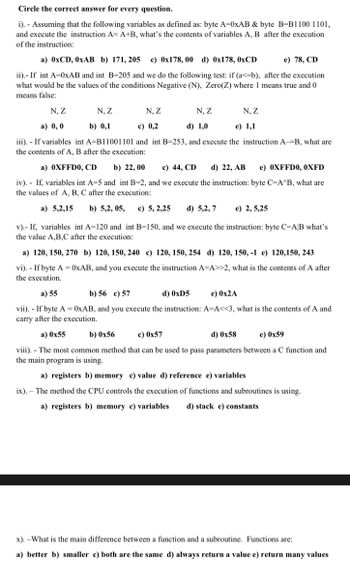
Introductory Circuit Analysis (13th Edition)
13th Edition
ISBN: 9780133923605
Author: Robert L. Boylestad
Publisher: PEARSON
expand_more
expand_more
format_list_bulleted
Question
Answer Quickly please!

Transcribed Image Text:Circle the correct answer for every question.
i). Assuming that the following variables as defined as: byte A=0xAB & byte B=B1100 1101,
and execute the instruction A=A+B, what's the contents of variables A, B after the execution
of the instruction:
a) 0xCD, 0xAB b) 171, 205 c) 0x178, 00 d) 0x178, 0xCD
e) 78, CD
ii).- If int A=0xAB and int B-205 and we do the following test: if (a<=b), after the execution
what would be the values of the conditions Negative (N), Zero(Z) where 1 means true and 0
means false:
N, Z
N, Z
N, Z
N, Z
N, Z
a) 0,0
b) 0,1
c) 0,2
d) 1,0
e) 1,1
iii). If variables int A=B11001101 and int B-253, and execute the instruction A-B, what are
the contents of A, B after the execution:
c) 44, CD d) 22, AB
a) 0XFFD0, CD b) 22,00
e) 0XFFD0, 0XFD
iv). If, variables int A-5 and int B-2, and we execute the instruction: byte C=A^B, what are
the values of A, B, C after the execution:
a) 5,2,15 b) 5,2, 05, c) 5, 2,25
d) 5,2, 7 e) 2,5,25
v). If, variables int A=120 and int B=150, and we execute the instruction: byte C=A|B what's
the value A,B,C after the execution:
a) 120, 150, 270 b) 120, 150, 240 c) 120, 150, 254 d) 120, 150, -1 e) 120,150, 243
vi). If byte A = 0xAB, and you execute the instruction A=A>>2, what is the contents of A after
the execution.
a) 55
b) 56 c) 57
d) 0xD5
e) 0x2A
vii). If byte A = 0xAB, and you execute the instruction: A=A<<3, what is the contents of A and
carry after the execution.
a) 0x55
b) 0x56
c) 0x57
d) 0x58
e) 0x59
viii). The most common method that can be used to pass parameters between a C function and
the main program is using.
a) registers b) memory c) value d) reference e) variables
ix). The method the CPU controls the execution of functions and subroutines is using.
a) registers b) memory c) variables
d) stack e) constants
x). What is the main difference between a function and a subroutine. Functions are:
a) better b) smaller c) both are the same d) always return a value e) return many values
Expert Solution
This question has been solved!
Explore an expertly crafted, step-by-step solution for a thorough understanding of key concepts.
Step by stepSolved in 2 steps

Knowledge Booster
Similar questions
- 19. When you're connecting a bonding jumper to the structural steel of a building, the jumper must remainaccessible unless it'sA. located within five feet of the service equipment.B. covered in fireproofing material.C. behind a metal panel.D. inside a wall areaarrow_forwardplease solve step by step subject: power system Protectionarrow_forwardDraw circuit diagram of a cross over in a two speaker system? What is its operation?arrow_forward
arrow_back_ios
arrow_forward_ios
Recommended textbooks for you
 Introductory Circuit Analysis (13th Edition)Electrical EngineeringISBN:9780133923605Author:Robert L. BoylestadPublisher:PEARSON
Introductory Circuit Analysis (13th Edition)Electrical EngineeringISBN:9780133923605Author:Robert L. BoylestadPublisher:PEARSON Delmar's Standard Textbook Of ElectricityElectrical EngineeringISBN:9781337900348Author:Stephen L. HermanPublisher:Cengage Learning
Delmar's Standard Textbook Of ElectricityElectrical EngineeringISBN:9781337900348Author:Stephen L. HermanPublisher:Cengage Learning Programmable Logic ControllersElectrical EngineeringISBN:9780073373843Author:Frank D. PetruzellaPublisher:McGraw-Hill Education
Programmable Logic ControllersElectrical EngineeringISBN:9780073373843Author:Frank D. PetruzellaPublisher:McGraw-Hill Education Fundamentals of Electric CircuitsElectrical EngineeringISBN:9780078028229Author:Charles K Alexander, Matthew SadikuPublisher:McGraw-Hill Education
Fundamentals of Electric CircuitsElectrical EngineeringISBN:9780078028229Author:Charles K Alexander, Matthew SadikuPublisher:McGraw-Hill Education Electric Circuits. (11th Edition)Electrical EngineeringISBN:9780134746968Author:James W. Nilsson, Susan RiedelPublisher:PEARSON
Electric Circuits. (11th Edition)Electrical EngineeringISBN:9780134746968Author:James W. Nilsson, Susan RiedelPublisher:PEARSON Engineering ElectromagneticsElectrical EngineeringISBN:9780078028151Author:Hayt, William H. (william Hart), Jr, BUCK, John A.Publisher:Mcgraw-hill Education,
Engineering ElectromagneticsElectrical EngineeringISBN:9780078028151Author:Hayt, William H. (william Hart), Jr, BUCK, John A.Publisher:Mcgraw-hill Education,

Introductory Circuit Analysis (13th Edition)
Electrical Engineering
ISBN:9780133923605
Author:Robert L. Boylestad
Publisher:PEARSON

Delmar's Standard Textbook Of Electricity
Electrical Engineering
ISBN:9781337900348
Author:Stephen L. Herman
Publisher:Cengage Learning

Programmable Logic Controllers
Electrical Engineering
ISBN:9780073373843
Author:Frank D. Petruzella
Publisher:McGraw-Hill Education

Fundamentals of Electric Circuits
Electrical Engineering
ISBN:9780078028229
Author:Charles K Alexander, Matthew Sadiku
Publisher:McGraw-Hill Education

Electric Circuits. (11th Edition)
Electrical Engineering
ISBN:9780134746968
Author:James W. Nilsson, Susan Riedel
Publisher:PEARSON

Engineering Electromagnetics
Electrical Engineering
ISBN:9780078028151
Author:Hayt, William H. (william Hart), Jr, BUCK, John A.
Publisher:Mcgraw-hill Education,